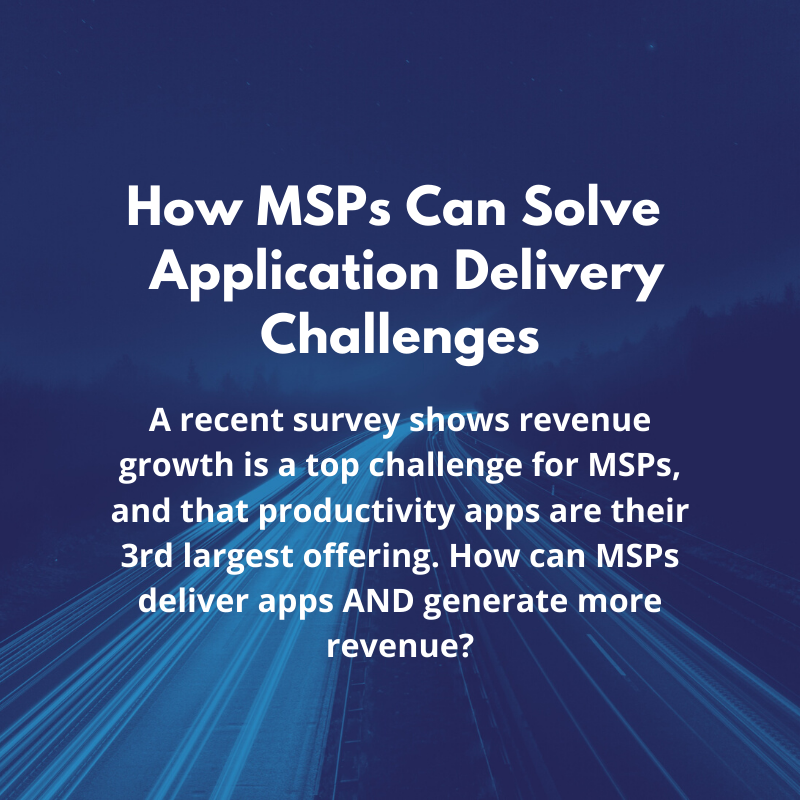According to a recent survey of 1,600+ MSPs for the 2019 “State of the MSP Report” by Datto (download the full report here), one of the top three problems that MSPs faced in 2019 was revenue growth. Also revealed in that survey, “Productivity Software” came in at #3 in the top products and services offered by MSPs in 2019. Those two stats illustrate a key challenge (and opportunity) for MSPs – the ability to drive additional revenue by simplifying the delivery of critical productivity software.
Every MSP relies on their ability to establish competitive differentiation, and the best way to accomplish that is to provide greater value to their customers. So when it comes to providing customers a better experience with productivity applications, and doing so in a way that can also generate revenue growth for the MSP, what’s standing in the way? 
In general, most MSPs face three key challenges when it comes to revenue generation and the delivery of applications:
- Delivering value-added services in a cost-effective manner
- Providing solutions that are simple – both for their customers to use, and for them to manage
- Empowering customers with flexible solutions that enable them to scale up/down based on business needs
Cost-Effective Services
When it comes to delivering virtual applications, the legacy choices – virtual desktop infrastructure (VDI) like Citrix and traditional application virtualization like VMware – have been exceptionally costly to provide and manage. Most MSPs don’t want to introduce complex, pre-cloud technologies as a way to “solve” for application delivery. In addition to the cost and complexity, when it comes to virtual application delivery, VDI is simply overkill.
In order for MSPs to cost-effectively deliver any legacy Windows application to any device, they need a built-for-the-cloud platform that eliminates the need for VDI and application virtualization. Cloud-native virtual application delivery platforms enable MSPs to easily add any applications their customers need and publish those apps only to the users that need access, providing a simple way to offer application delivery at an attractive price, which presents a new revenue opportunity for MSPs.
Simplicity (for MSPs AND their Customers)
No MSP wants to introduce complexity into any deal. Not only because they are the ones who have to deal with that complexity, but because customers turn to their MSPs to help them reduce complexity. That is a key part of the value proposition of most MSPs. So when it comes to providing virtual access to the productivity applications that customers rely on, MSPs need to prioritize solutions that enable a simple, seamless user experience. Better access to their productivity applications on any device AND a better user experience is the type of value-add that customers are looking for from their MSP.
Similarly, that simplicity needs to carry over to the MSP. Complexity gets in the way of an MSP being able to sell. If a solution provides a good end-user experience but is a nightmare to manage for the MSP, then that is not a viable long-term solution. Some virtual application delivery platforms can enable MSPs to onboard customers and publish applications to them within minutes, with fully-automated billing to make the entire process as simple as possible.
Flexibility to Meet Changing Customer Needs
In addition to delivering solutions that are cost-effective and simple, MSPs also need to provide solutions that enable their customers to scale up and down as their business needs change. Consider a situation where a customer starts with a trial or a proof of concept so that they can test out delivering applications to 50 users on various devices/OSs. MSPs need platforms and solutions that are flexible enough to quickly and easily allow customers to expand to thousands of users without friction. Likewise, that same customer should be able to reduce their number of users if their needs change.
VDI and application virtualization product require significant infrastructure investments which are not only costly, but they are inflexible. Virtual application delivery platforms enable MSPs to quickly get their customers up and running, with the ultimate in flexibility to ensure the customer is always able to scale as needed with limited involvement from the MSP.
Are you an MSP facing these challenges? How are you addressing them today? And what other key challenges are you dealing with?
